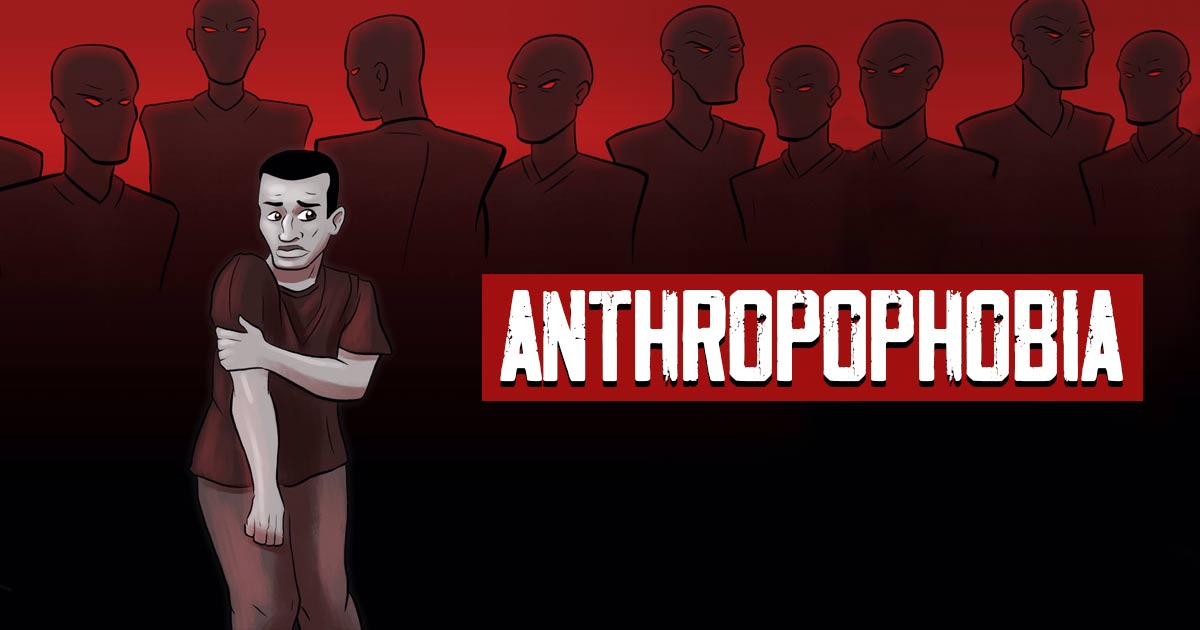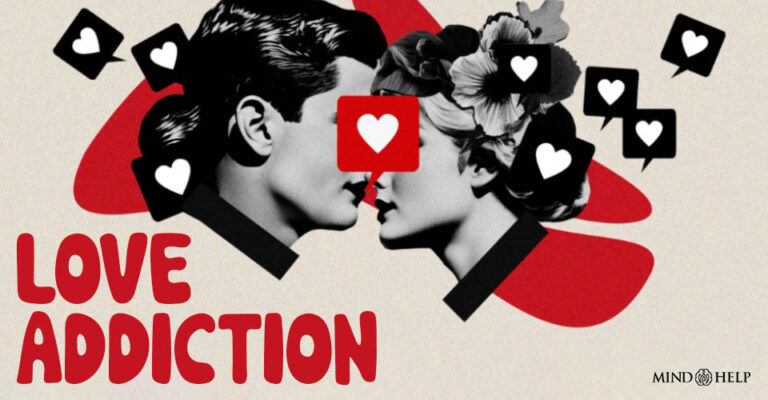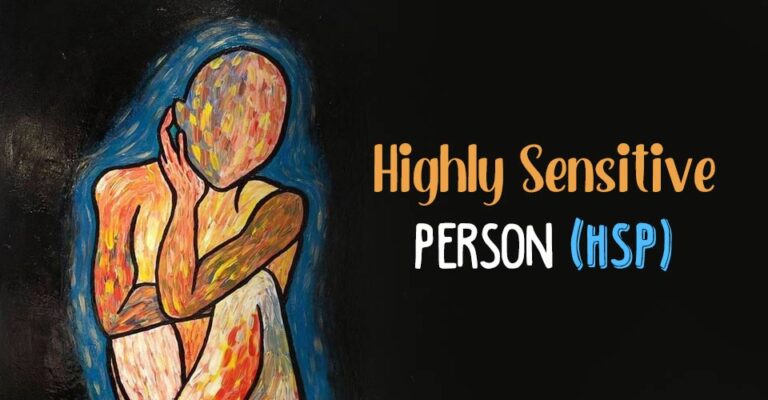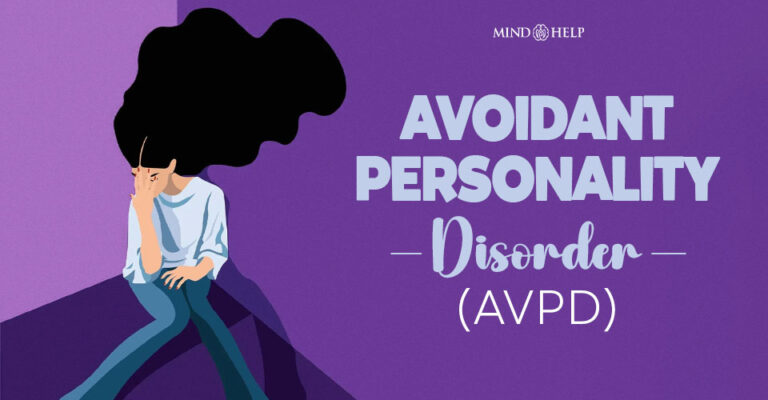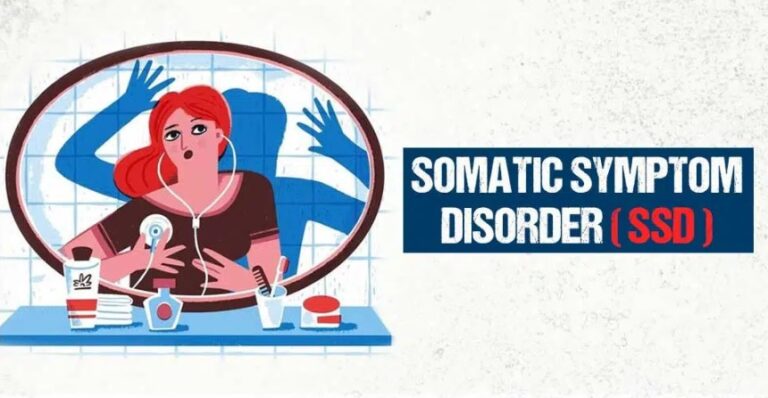Humans are, by nature, social animals. Connecting with people is key for our mental and emotional wellbeing. However, anthropophobia, the fear of human beings, is a mental health condition that prevents us from building social connections.
What Is Anthropophobia?
Anthropophobia is the irrational fear of humans. Derived from the Greek terms “ánthropos” meaning human and “phóbos” meaning fear, this phobia is also known as anthrophobia. It is also related to Taijin kyofusho 1 Sharpless, B. A., Balko, A. L., & Grom, J. L. (2016). Taijin Kyofusho. Oxford University Press EBooks, 177–195. https://doi.org/10.1093/med:psych/9780190245863.003.0013 , a culture-specific syndrome observed in Japan and Korea.
A person with this condition 2 Zhang, A. Y., Yu, L. C., Zhang, J., Tang, D., & Draguns, J. G. (2001). Anthropophobia: Its Meaning and Concomitant Experiences. International Journal of Social Psychiatry, 47(4), 56–70. https://doi.org/10.1177/002076400104700405 may be afraid of making eye contact with people and exhibit unnatural facial expressions in the presence of people. For people with this condition, a simple interaction may be extremely uncomfortable and distressing. In fact, depending on the severity, some individuals actively leave their education or career to isolate themselves and avoid seeing others.
This phobia may be triggered in all or most situations 3 Ogawa, T., & Bouderlique, J. (1994). L’Anthropophobie: approche psychopathologique des interactions entre corps, intersubjectivité et langage [Anthropophobia: psychopathological approach to the interactions between body, inter-subjectivity and language]. The Japanese journal of psychiatry and neurology, 48(3), 527–532. . Context and familiarity barely make a difference on an anthropophobic person’s capacity to interact with another person. Hence, they can be as much afraid of family members and close friends as complete strangers.
Anthropophobia generally develops during adolescence 4 Zhang, A. Y., Yu, L. C., Draguns, J. G., Zhang, J., & Tang, D. (2000). Sociocultural contexts of anthropophobia: a sample of Chinese youth. Social psychiatry and psychiatric epidemiology, 35(9), 418–426. https://doi.org/10.1007/s001270050259 , especially between the ages of 13 and 18 years. A study 5 Shimizu, K., Kawabe, H., & Kaizuka, T. (2007). Shinrigaku kenkyu : The Japanese journal of psychology, 78(1), 9–16. https://doi.org/10.4992/jjpsy.78.9 has also found an interrelationship between anthropophobic tendencies and narcissistic personality in adolescents.
However, it should be noted that Anthropophobia is separate from misanthropy. The former is an anxiety disorder whereas the latter is a dislike of humankind. Misanthropy is related with a distrust and hatred of humanity which is completely different from a phobia.
Read More About Phobia Here
Anthropophobia vs. Social Phobia
Anthropophobia may be considered as a form of social anxiety disorder, however, the terms are slightly different from each other. People with social phobia tend to feel anxious when at a party or interacting with strangers. They feel threatened by the thought of being negatively, judged, humiliated, embarrassed or rejected by society and people. Hence they tend to avoid social situations.
An anthropophobic feels threatened by people irrespective of the social setting. People with social phobia usually feel comfortable in situations where they can be anonymous. But individuals suffering from anthropophobia feel the same level of intense anxiety 6 Zhang, A. Y., Yu, L. C., Zhang, J., Tang, D., & Draguns, J. G. (2001). Anthropophobia: Its Meaning and Concomitant Experiences. International Journal of Social Psychiatry, 47(4), 56–70. https://doi.org/10.1177/002076400104700405 whether they are the center of attention or hiding in the background.
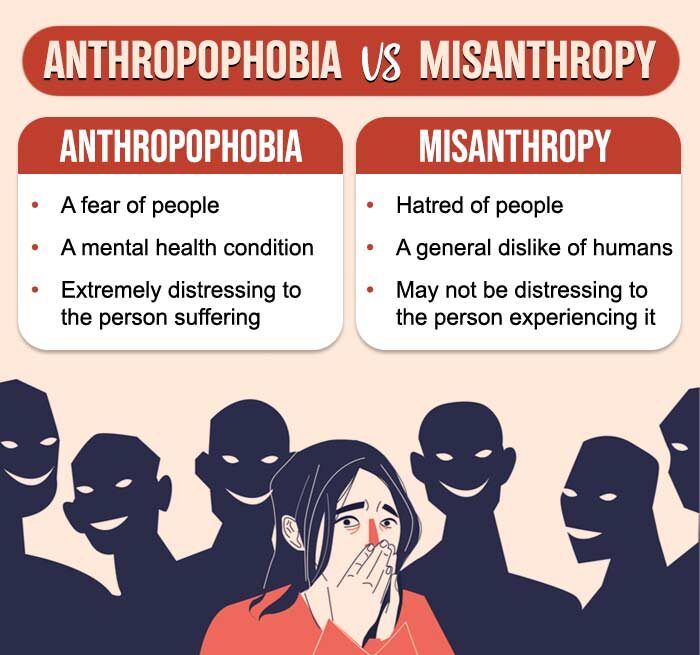
Case Example
Manish, a 32-year-old man, quit his job a year ago and has since remained isolated in his room, cutting off all contact with the outside world. He only leaves his room for essential activities such as eating or getting water. His wife reports that he has been struggling with interpersonal interactions and avoiding eye contact for the past 18 months.
He would also experience physical symptoms such as increase in heartbeat, palpitations, and shortness of breath during face-to-face contact with other people. He was even scared of his own family members and refused to come out of his room when guests were over.
Manish was preoccupied with the idea that his presence was uncomfortable to others and was scared that his behavior would be offensive to people. Thus, the fear of having to be around people constantly distressed him.
Even before he completely shut himself in his room, Manish apparently never stepped out of the house without wearing a cap, or sunglasses, and generally avoided invitations and social events.
Case Analysis
It is apparent from Manish’s symptoms that he was suffering from an intense and unreasonable fear of people, also known as anthropophobia.
Symptoms Of Anthropophobia
Anthropophobia symptoms are similar to typical symptoms of other phobias.
While interacting with others, whether in a group setting or personally, an anthropophobic person may experience any of the physical and psychological symptoms mentioned below.
1. Physical symptoms:
- Dizziness & nausea
- Sweating
- Trembling and shaking
- Shortness of breath
- Choking
- Choking sensations
- Increased heart rate
- Increased blood pressure
- Crying or yelling
2. Psychological symptoms
- Extreme fear and discomfort on meeting people or thinking about it
- Feeling anticipatory anxiety 7 Boehme, S., Ritter, V., Tefikow, S., Stangier, U., Strauss, B., Miltner, W. H. R., & Straube, T. (2013). Brain activation during anticipatory anxiety in social anxiety disorder. Social Cognitive and Affective Neuroscience, 9(9), 1413–1418. https://doi.org/10.1093/scan/nst129 about meeting people
- Fear of judgment
- Inability to make eye contact
- A strong need to escape situations where there are people
- Taking extreme measures to avoid people and social events
In extreme cases, anthropophobics may also have the fear of death when exposed to other people or social situations.
Anthropophobia Causes
Research 8 Mayo Clinic. (2016, October 19). Specific Phobias – Symptoms and Causes. Mayo Clinic. Available from: https://www.mayoclinic.org/diseases-conditions/specific-phobias/symptoms-causes/syc-20355156 is yet to determine the exact causes of anthopophobia. Experts believe that multiple factors like genetics, environmental factors, and childhood experiences can play a significant role in its development.
Here are some of the probable factors that may lead to a risk of Anthropophobia.
1. Traumatic experiences
Negative experiences in the past or in childhood can lead to the development of different phobias, including the fear of people. Past trauma, such as being abused by caregivers that one trusts the most, or experiencing a violent crime can lead to the development of this mental disorder.
2. Family history
Genetics often play a significant role in the development of phobias. A person is more likely to develop anthropophobia if someone in their family suffers from it. This could either be a result of an inherited tendency or learned behavior 9 Fryling, M. J., Johnston, C., & Hayes, L. J. (2011). Understanding observational learning: an interbehavioral approach. The Analysis of verbal behavior, 27(1), 191–203. https://doi.org/10.1007/BF03393102 . As this phobia tends to develop during adolescence, children may learn such behavior by observing a parent or caregiver’s phobic reaction to other people.
3. Other conditions
Individuals with other mental disorders or neurological conditions could also develop a fear of other people. People with bipolar disorder or schizophrenia or those on the autism spectrum may prefer to remain alone and away from others.
Apart from these, people with a tendency of being overanxious and paranoid may also become afraid of others. Individuals with physical issues and adrenal insufficiency may be prone to this phobia as well.
4. Culture
Culture and environment can also be a crucial factor in the development of phobias like anthropophobia and social phobia. The culture-specific syndrome Taijin kyofusho is a fear of interpersonal relations and is common among the people of Japan. This culture-bound disorder affects 10-20% of Japanese 10 Taijin Kyofusho Is a Culturally-Bound Anxiety Disorder of the Japanese. Verywell Mind. Available from: https://www.verywellmind.com/taijin-kyofusho-2671839 people with more men impacted by it than women.
Anthropophobia Diagnosis
Anthropophobia can be regarded as a specific phobia, even though it has not been identified as a clinical disorder in the fifth edition of the Diagnostic and Statistical Manual of Mental Disorders (DSM-5 11 American Psychiatric Association. (2013). Diagnostic and Statistical Manual of Mental Disorders (DSM-5-TR). Psychiatry.org; American Psychiatric Association. Available from: https://www.psychiatry.org/psychiatrists/practice/dsm ). Sometimes, it is also diagnosed as a social phobia.
Some of the common criteria for diagnosing anthropophobia are:
- Exposure to people or social situations leads to stress, and fear.
- The person avoids interacting with people whenever possible.
- The phobic reaction to people or social situations is unjustifiably larger than the actual threat or danger.
- The fear and anxiety results in notable distress which affects the person’s daily life.
- The symptoms last for a period of at least 6 months.
- The symptoms are not due to any other medical condition or mental health disorder.
To diagnose a person with anthropophobia, a mental health professional first evaluates the symptoms and takes a detailed history. There are no well-known tests for anthropophobia, so the diagnosis is primarily based on clinical observation.
How To Overcome Anthropophobia
Phobias are generally treatable conditions. There are several therapies that can be employed for anthropophobia treatment.
Some of the methods for treatment of anthropophobia are
1. Therapy
Therapy can prove especially helpful when the condition is identified during the initial stages. Some of the commonly used therapies for treating phobias include:
Cognitive therapy
Cognitive therapy 12 Cognitive Therapy (CT). (2020). Apa.org. Available from: https://www.apa.org/ptsd-guideline/treatments/cognitive-therapy can help a person modify the negative automatic thoughts underlying the fear of people and replace them with more adaptive ones. Cognitive therapy is a solution-oriented approach that is applied widely to treat various mental disorders.
Exposure therapy
Exposure therapy 13 American Psychological Association. (2017, July). What Is Exposure Therapy? Https://Www.apa.org. Available from: https://www.apa.org/ptsd-guideline/patients-and-families/exposure-therapy is a type of behavioral training that exposes a person to the object or situation they are afraid of in a controlled setting, in a step-by-step manner.
Exposure therapy can start off with the therapist asking the patient to visualize being around and interacting with people, using images, videos, or virtual reality. This helps the patient to overcome their anxiety without actually experiencing any threat or danger.
Relaxation techniques
Relaxation techniques 14 Norelli, S. K., Long, A., & Krepps, J. M. (2020). Relaxation Techniques. PubMed; StatPearls Publishing. Available from: https://www.ncbi.nlm.nih.gov/books/NBK513238/ can greatly help reduce the physical symptoms of anxiety. Progressive muscle relaxation and autogenic training are some methods of relaxation therapy. Some alternative relaxation techniques include yoga, meditation, tai chi, and guided hypnosis.
These can be highly effective, especially when used along with therapy. Relaxation training can help alleviate physical and emotional symptoms of Anthropophobia and help them better manage their stress response.
2. Medication
Although there are no specific medications for this condition, certain medicines can help to relieve the anxiety symptoms associated with specific phobias. Medications like beta-blockers 15 Felman, A. (2021, February 17). Beta-blockers: Types, side effects, and interactions. Www.medicalnewstoday.com. Available from: https://www.medicalnewstoday.com/articles/173068 , Selective serotonin reuptake inhibitors (SSRIs 16 Mayo Clinic. (2019, September 17). Selective Serotonin Reuptake Inhibitors (SSRIs). Available from: https://www.mayoclinic.org/diseases-conditions/depression/in-depth/ssris/art-20044825 ) or anti-anxiety medications may be helpful.
However, it should be noted that these medications only suppress the symptoms and do not actually treat the phobia. Moreover, medication might not be the best treatment option for every patient. This is why it is crucial to consult a medical professional for seeking treatment for anthropophobia.
Read More About Meditation Here
Takeaway
Anthropophobia is a very difficult condition to deal with as we are constantly surrounded by people. However, with proper support from your therapist and loved ones, it is possible to overcome your phobia of people.
Accepting support from your trusted family and friends can make the recovery process easier and more effective. Moreover, adapting a healthy lifestyle and a positive mindset can also make you feel better and deal with the symptoms of anthropophobia more effectively.
At A Glance
- Anthropophobia, the fear of human beings, is a mental health condition that prevents us from building social connections.
- For people with this condition, a simple interaction can feel like a traumatic experience.
- Generally, anthropophobia can develop during adolescence.
- People with anthropophobia may feel distressed, discomfort, high levels of anxiety, increased heartbeat, inability to speak when in the company of another person.
- There exist several types of anthropophobia treatment.
- Depending on the severity of the phobia, a professional may suggest treatments like therapies, relaxation techniques, and medication.
Frequently Asked Questions (FAQs)
1. Is anthropophobia social anxiety disorder?
Although the two terms are often used interchangeably, there is a slight difference between them. While social anxiety is restricted to social situations, anthropophobia is the fear of people irrespective of the social environment.
2. How common is anthropophobia?
Not a lot of research has been conducted on the prevalence of anthropophobia. It is an extremely rare condition.
3. Are there long-term effects of anthropophobia?
Long-term effects of living with anthropophobia may include an inability to maintain jobs, poor inter-personal relationships, and life dissatisfaction.
4. Is there a permanent cure for anthropophobia?
Anthropophobia can be cured with long-term exposure and cognitive therapy under the guidance of a professional. A support system and a willingness to work on the issue on the part of the suffering person can also act as effective facilitators.
